Ficus "Moklame": features, planting and care

Ficus microcarpa "Moklame" (from Lat. Ficus microcarpa Moclame) is a popular ornamental plant and is often used for interior decoration, winter gardens and landscapes. The tree is a frequent participant in group compositions, and also looks good when placed alone.
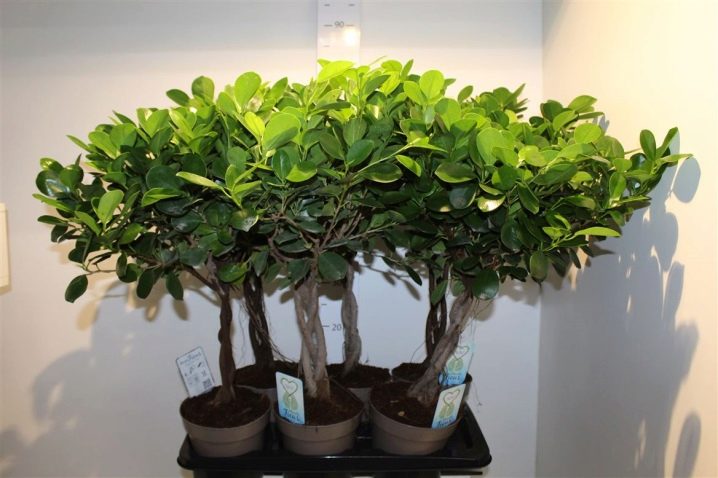
Description
Ficus "Moklame" is a typical representative of the mulberry family and grows in tropical and subtropical zones. The height of an adult tree growing in natural nature can reach 25 m, moreover, when kept indoors, it barely reaches one and a half meters. The countries of the East, as well as Australia and the Philippines, where the tree is positioned as a symbol of love, fertility and wisdom, are considered the birthplace of Moklame. In our country, the plant is widespread and highly valued by landscape designers and interior specialists.
Unlike most other ficuses the tree is characterized by the presence of a large number of aerial roots and ellipsoidal leaves... The bark of the plant has a gray tint and a rather weak texture. Bright green leaf blades are distinguished by a solid structure and a glossy surface.
The plant owes its name to small fruits (“moklama” - from the Greek “small fruit”), the seed size of which does not exceed one centimeter (“microcarp” - from the Latin “small-fruited”). Ficus fruits are small red inedible berries, however, it is quite difficult to obtain them with indoor breeding: flowering is a rather energy-intensive process, so it rarely happens at home.
Ficus "Moklame" is characterized not only by high decorative characteristics, but also has some medicinal properties.
So, infusions and decoctions of leaves are significantly relieve radiculitis, arthritis and mastopathy, and the tree itself has a disinfecting effect and cleans the air well from benzene vapors, phenol and other harmful impurities. In addition, his presence has a beneficial effect on the state of mind of those present, relieves irritability, anger and excessive aggression.
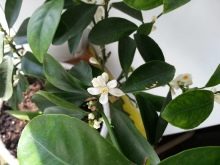

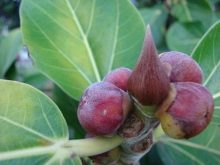
Reproduction
The best time for reproduction of the ficus "Moklame" is spring, and the optimal way is grafting... The procedure consists of several stages and consists in the following: a strong and healthy shoot 10-15 cm long is cut from the tree trunk using a sharp knife.
Prerequisites are the presence of a thin bark, which has already begun to form on the shoot, and cutting at a certain angle. In this case, the juice flowing from the cutting is washed off, and the lower branches and young leaves are removed. Next, the cut of the cutting is dried a little, after which it is placed in a container with settled water at room temperature and placed in a warm place. Wherein it is necessary to ensure that the water does not reach the leaves, otherwise they will begin to rot.
An activated carbon tablet can be added to the water as a disinfectant.
After a couple of weeks, young roots appear at the cutting, which is a signal that the plant can be planted. Usually used as a substrate for planting perlite, sand and peat, taken in equal proportions. After the young shoot takes root and takes root, it will need to cut off all leaves except the top two, and fertilize after a couple of weeks.After 3 months, the plant should be transplanted to a permanent place in a perforated pot with a diameter of at least 10 cm.
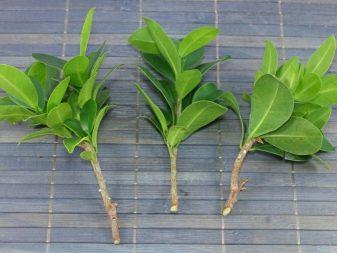
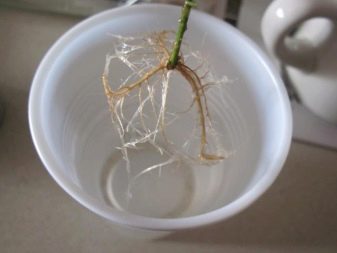
Some experts recommend plant the cutting directly into moistened soil... This, in their opinion, will completely prevent the likelihood of shoot decay and contribute to the good rooting of the sprout. However, this method requires creating greenhouse conditions for cutting, and if it is not possible to create such conditions, then you can simply cover the sprout with a glass jar, which is not recommended to be removed until rooting.
Another breeding method is sowing ficus seeds... To do this, they are pre-processed growth stimulant and disinfected. Then the seeds are placed in moist, loose soil and placed in a warm place.
An important condition for seed germination is constant soil moisture. However, it is necessary to maintain a balance and try to prevent excessive moisture.
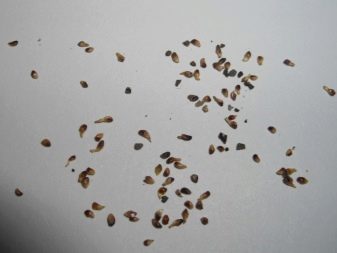
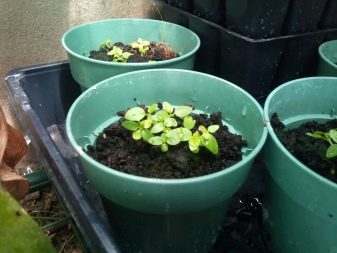
Transfer
It is recommended to transplant the plant into a new pot in cases where the roots no longer fit in the old container or braid the soil too tightly. Recently purchased plants, which are sold in temporary flowerpots, also require transplants. The transplant should be done in the spring or summer months. with the expectation that before the onset of winter, the plant must have time to adapt well to a new place and gain strength. Repotting a mature tree too often is not recommended., since its trunk and root system grow very slowly.
As the ficus grows, each subsequent pot should be 5 cm larger than the previous one in diameter and must have perforations to drain excess moisture. Average the pot is replaced every 3 years, moreover, the tree is transplanted exclusively by the method of transferring soil from one container to another, and the missing volume of earth is poured along the edges of the pot.
This method guarantees the preservation of the native lump of earth and ensures good adaptation of the ficus in a new place.

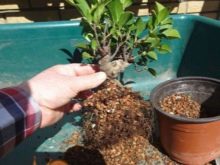

Separately, it should be said about the soil for "Moklame". So, the soil for transplanting ficus should have low acidity or neutral pH... Usually, the soil is purchased in specialized stores or prepared independently. For this, a mixture of charcoal, turf, sand and leaf humus, taken in equal parts, is used.
The ingredients are mixed well and fried in the oven for 15-20 minutes. Then the bottom of the pot is laid out with expanded clay and a layer of sand is poured on top. On top of the equipped drainage, the cooled disinfected soil is placed and the planting or transplantation begins.


How to care?
It is quite easy to take care of the Moklame ficus at home. The plant is unpretentious and does not need to create any special conditions. Care consists in systematic watering, creating optimal conditions for temperature, humidity and illumination, as well as making additional fertilizing and forming the crown.
- Watering ficus is carried out with soft water room temperature, settled for 12 hours. Moistening begins only after the top layer of earth 3 cm thick has become dry. In such conditions, the earthen lump, although it still holds a certain amount of moisture, already needs replenishment.
In the spring and summer, watering is carried out more actively, while in the autumn and winter periods it is noticeably reduced and is done every 2 weeks.
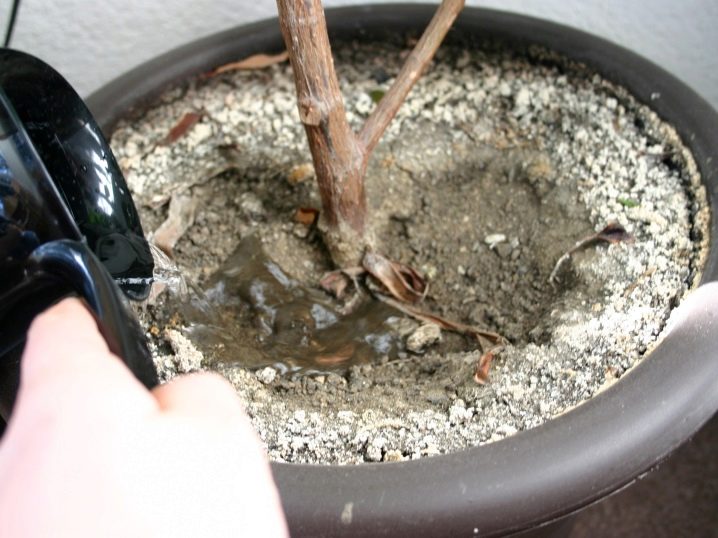
- Temperature and humidity... The most favorable for ficus "Moklame" is the air temperature in summer - 25-30 degrees Celsius, in winter - 16-20. In this case, the main thing is to prevent hypothermia of the earth, therefore, in the winter months, the plant should be removed from the cold floor or windowsill. To do this, you can use a special stand, and in case of its absence, use a cloth folded in several layers, wrapping the pot with it.
The air humidity in the room should be comfortable 50-70%, and in the summer months, the ficus can be additionally sprayed or once a month arrange a warm shower for it. It is not recommended to leave the remaining water in the sump.
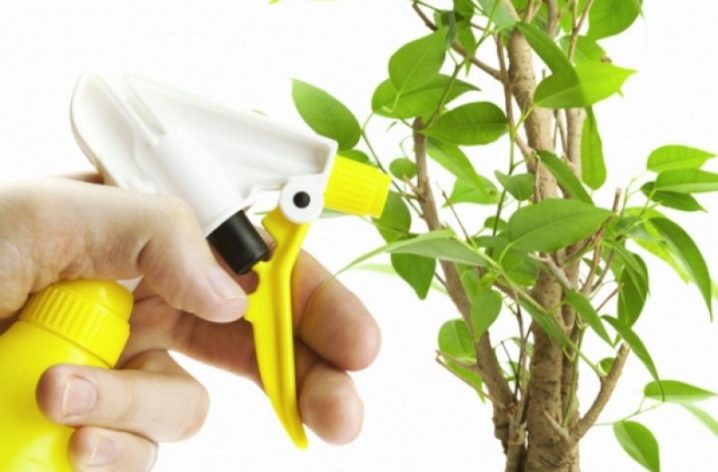
- Lighting... Ficus "Moklame" loves light of moderate intensity, and when grown outdoors should be placed next to the west or east side of the building. In the winter months, it is recommended to additionally illuminate the tree with fluorescent lamps, extending the daylight hours, which for ficus should be at least 8-10 hours. You should also know that if the plant has taken root in a certain place, then it is not recommended to rearrange it to another place.
Ficus is very conservative in terms of lighting and can get sick with changing insolation conditions.

- Top dressing... Ficus "Moklame" needs annual feeding. So, at the beginning of spring, it is recommended to fertilize the plant with universal complex preparations for ficuses, in the summer months you need to make a little nitrogenous fertilizers, and in the fall and winter - do not do any fertilizing and leave the tree alone.

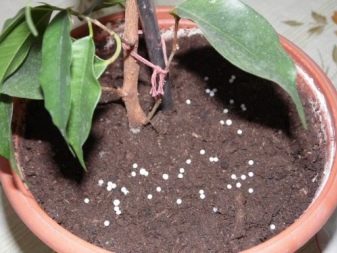
- Pruning ficus is necessary to remove old and damaged leaves and shoots, as well as to form a beautiful crown. The procedure is usually performed in the spring, which allows new branches to grow stronger over the summer and prepare well for winter. The first step is to cut off the upper kidney, activating the development of the lateral ones in a similar way. This is due to the rapid growth of the apical buds, which noticeably slow down the growth of the rest.
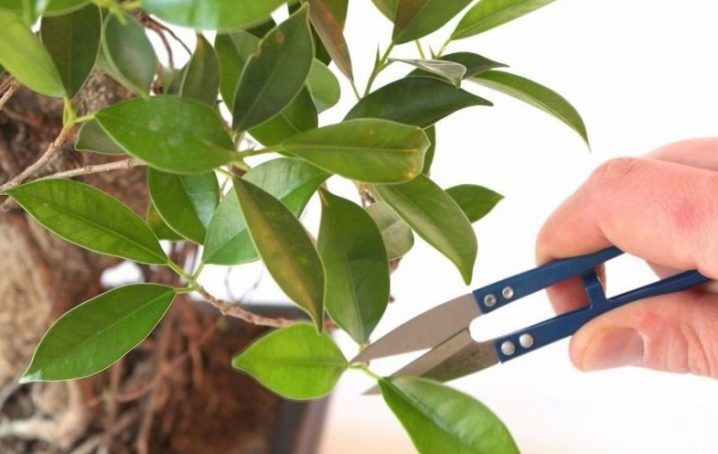
Ficus is often used to form bonsai, while removing all the leaves located below, shoots and pinching off about 10 cm from the top.After the axillary shoots grow to the same height, they are also pruned. This allows you to form a beautiful stem, and at the same time get rid of old leaves. At the same time, the cut points are wiped with a clean napkin and sprinkled with charcoal.
As mentioned above, the ficus "Moklame" practically does not bloom at home. However, if this still happened, then at the end of flowering, it is recommended to remove the fruits that have appeared - syconia, otherwise the tree will become lethargic and lifeless.
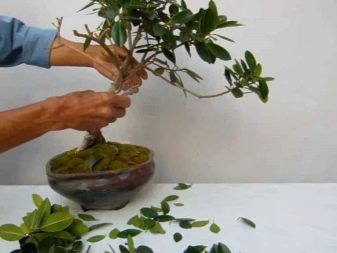

Ailments and pests
Most often, ficus owners complain that leaves are falling from the tree. This, as a rule, is a consequence of flaws in care and indicates excess or lack of watering, sudden temperature changes or poor lighting... An equally common problem is root decay, which is possible due to a poorly equipped drainage system or the lack of holes for excess moisture to escape.
As for pests, Moklam is sometimes attacked spider mite, aphid, mealybug, whitefly or scale insect.
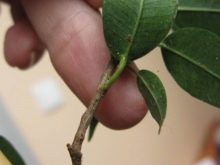

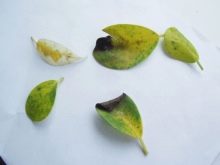
For their destruction, the use of insecticidal preparations, soapy water and land replacement are very helpful.
For information on how to pinch a ficus, see the next video.































The comment was sent successfully.